Impact of Recycled Aggregate on the Mechanical and Environmental Properties of Concrete: A Review
Abstract
:1. Introduction
2. Materials and Methods
2.1. Study Selection, Elegibility and Search Strategy
2.2. Data Analysis
2.3. Study Selection
3. Results
3.1. Water Absorption of Reycled Aggregates
3.2. Water/Cement Ratio of Concrete with Recycled Aggregates
3.3. Workability of Concrete with Recycled Aggregates
3.4. Compressive Strength of Concrete with Recycled Aggregates
3.5. Other Mechanical Caractheristics
3.5.1. Tensile Strength
3.5.2. Elasticty Modulus
3.6. Other Properties
3.7. Leaching and Environmental Properties
4. Future Perspective
5. Conclusions
Author Contributions
Funding
Institutional Review Board Statement
Informed Consent Statement
Data Availability Statement
Conflicts of Interest
References
- Bourguignon, D. Material Use in the European Union: Towards a Circular Approach; European Union: Brussels, Belgium, 2018. [Google Scholar]
- Eurostat Generation of Waste by Economic Activity. Available online: https://ec.europa.eu/eurostat/databrowser/view/ten00106/default/table?lang=en (accessed on 23 December 2021).
- ISPRA. Rapporto Rifiuti Speciali 2021; Istituto Superiore per la Protezione e la Ricerca Ambientale: Rome, Italy, 2021. [Google Scholar]
- Barbudo, A.; Jiménez, J.R.; Ayuso, J.; Galvín, A.P.; Agrela, F. Catalogue of Pavements with Recycled Aggregates from Construction and Demolition Waste. Proceedings 2018, 2, 1282. [Google Scholar] [CrossRef] [Green Version]
- Eurostat Recovery Rate of Construction and Demolition Waste. Available online: https://ec.europa.eu/eurostat/databrowser/view/cei_wm040/default/table?lang=en (accessed on 23 December 2021).
- Diotti, A.; Sorlini, S.; Cominoli, L.; Grassi, S.; Plizzari, G. Valorization of CDWaste in the Construction Sector; Department of Civil, Environmental, Architectural Engineering, and Mathematics (DICATAM): Brescia, Italy, 2019. [Google Scholar]
- Martinez-Echevarria, M.J.; Lopez-Alonso, M.; Garach, L.; Alegre, J.; Poon, C.S.; Agrela, F.; Cabrera, M. Crushing Treatment on Recycled Aggregates to Improve Their Mechanical Behaviour for Use in Unbound Road Layers. Constr. Build. Mater. 2020, 263, 517. [Google Scholar] [CrossRef]
- Ronchi, E.; Leoni, S.; Vigni, F.; Pettinao, E.; Barucci, V.; Galli, L.; Sbaffoni, S.; Beltrani, T.; Cortesi, S.; Fantin, V. Rapporto sull’Economia Circolare in Italia; Fondazione per lo Sviluppo Sostenibile: Roma, Italy, 2021. [Google Scholar]
- Aggiornamento delle “Norme Tecniche per le Costruzioni”; Ministero delle Infrastrutture e Dei Trasporti: Rome, Italy, 2018; Volume 20.
- Silva, R.V.; de Brito, J.; Dhir, R.K. Properties and Composition of Recycled Aggregates from Construction and Demolition Waste Suitable for Concrete Production. Constr. Build. Mater. 2014, 65, 201–217. [Google Scholar] [CrossRef]
- Diotti, A.; Galvin, A.P.; Piccinali, A.; Plizzari, G.; Sorlini, S. Chemical and Leaching Behavior of Construction and Demolition Wastes and Recycled Aggregates. Sustainability 2020, 12, 326. [Google Scholar] [CrossRef]
- López-Uceda, A.; Ayuso, J.; López, M.; Jimenez, J.R.; Agrela, F.; Sierra, M.J. Properties of Non-Structural Concrete Made with Mixed Recycled Aggregates and Low Cement Content. Materials 2016, 9, 74. [Google Scholar] [CrossRef] [Green Version]
- De Brito, J.; Pereira, A.S.; Correia, J.R. Mechanical Behaviour of Non-Structural Concrete Made with Recycled Ceramic Aggregates. Cem. Concr. Compos. 2005, 27, 429–433. [Google Scholar] [CrossRef]
- Rodríguez, C.; Miñano, I.; Aguilar, M.Á.; Ortega, J.M.; Parra, C.; Sánchez, I. Properties of Concrete Paving Blocks and Hollow Tiles with Recycled Aggregate from Construction and Demolition Wastes. Materials 2017, 10, 1374. [Google Scholar] [CrossRef] [Green Version]
- Etxeberria, M.; Vázquez, E.; Marí, A.; Barra, M. Influence of Amount of Recycled Coarse Aggregates and Production Process on Properties of Recycled Aggregate Concrete. Cem. Concr. Res. 2007, 37, 735–742. [Google Scholar] [CrossRef]
- Tran, D.V.P.; Allawi, A.; Albayati, A.; Cao, T.N.; El-Zohairy, A.; Nguyen, Y.T.H. Recycled Concrete Aggregate for Medium-Quality Structural Concrete. Materials 2021, 14, 4612. [Google Scholar] [CrossRef]
- Rahal, K. Mechanical Properties of Concrete with Recycled Coarse Aggregate. Build. Environ. 2007, 42, 407–415. [Google Scholar] [CrossRef]
- Moher, D.; Liberati, A.; Tetzlaff, J.; Altman, D.G.; Altman, D.; Antes, G.; Atkins, D.; Barbour, V.; Barrowman, N.; Berlin, J.A.; et al. Preferred Reporting Items for Systematic Reviews and Meta-Analyses: The PRISMA Statement. PLoS Med. 2009, 6, e00176. [Google Scholar] [CrossRef] [Green Version]
- Hasan, A.; Golam Kibria, M.; Hasan, F.M.M. Effects of Incorporating Recycled Brick and Stone Aggregate as Replacement of Natural Stone Aggregate in Concrete. Int. J. Eng. Technol. Innov. 2019, 9, 38–48. [Google Scholar]
- Lavado, J.; Bogas, J.; de Brito, J.; Hawreen, A. Fresh Properties of Recycled Aggregate Concrete. Constr. Build. Mater. 2020, 233, 7322. [Google Scholar] [CrossRef]
- Pedro, D.; de Brito, J.; Evangelista, L. Structural Concrete with Simultaneous Incorporation of Fine and Coarse Recycled Concrete Aggregates: Mechanical, Durability and Long-Term Properties. Constr. Build. Mater. 2017, 154, 294–309. [Google Scholar] [CrossRef]
- Bravo, M.; de Brito, J.; Pontes, J.; Evangelista, L. Mechanical Performance of Concrete Made with Aggregates from Construction and Demolition Waste Recycling Plants. J. Clean. Prod. 2015, 99, 59–74. [Google Scholar] [CrossRef]
- Sheen, Y.N.; Wang, H.Y.; Juang, Y.P.; Le, D.H. Assessment on the Engineering Properties of Ready-Mixed Concrete Using Recycled Aggregates. Constr. Build. Mater. 2013, 45, 298–305. [Google Scholar] [CrossRef]
- Thomas, J.; Thaickavil, N.N.; Wilson, P.M. Strength and Durability of Concrete Containing Recycled Concrete Aggregates. J. Build. Eng. 2018, 19, 349–365. [Google Scholar] [CrossRef]
- Wang, Q.; Wang, Y.Y.; Geng, Y.; Zhang, H. Experimental Study and Prediction Model for Autogenous Shrinkage of Recycled Aggregate Concrete with Recycled Coarse Aggregate. Constr. Build. Mater. 2021, 268, 1197–1201. [Google Scholar] [CrossRef]
- Eckert, M.; Oliveira, M. Mitigation of the Negative Effects of Recycled Aggregate Water Absorption in Concrete Technology. Constr. Build. Mater. 2017, 133, 416–424. [Google Scholar] [CrossRef]
- Haitao, Y.; Shizhu, T. Preparation and Properties of High-Strength Recycled Concrete in Cold Areas. Mater. Constr. 2015, 65, 3214. [Google Scholar] [CrossRef] [Green Version]
- Lima, P.R.L.; Leite, M.B.; Santiago, E.Q.R. Recycled Lightweight Concrete Made from Footwear Industry Waste and CDW. Waste Manag. 2010, 30, 1107–1113. [Google Scholar] [CrossRef] [PubMed]
- Zhu, L.; Zhao, C.; Dai, J. Prediction of Compressive Strength of Recycled Aggregate Concrete Based on Gray Correlation Analysis. Constr. Build. Mater. 2021, 273, 175–179. [Google Scholar] [CrossRef]
- Bidabadi, M.S.; Akbari, M.; Panahi, O. Optimum Mix Design of Recycled Concrete Based on the Fresh and Hardened Properties of Concrete. J. Build. Eng. 2020, 32, 1483. [Google Scholar] [CrossRef]
- Rashid, K.; Rehman, M.U.; de Brito, J.; Ghafoor, H. Multi-Criteria Optimization of Recycled Aggregate Concrete Mixes. J. Clean. Prod. 2020, 276, 4316. [Google Scholar] [CrossRef]
- Zhang, Y.; Gao, L.; Bian, W. Mechanical Performance of Concrete Made with Recycled Aggregates from Concrete Pavements. Adv. Mater. Sci. Eng. 2020, 2020, 5763. [Google Scholar] [CrossRef]
- Lei, B.; Liu, H.; Yao, Z.; Tang, Z. Experimental Study on the Compressive Strength, Damping and Interfacial Transition Zone Properties of Modified Recycled Aggregate Concrete. R. Soc. Open Sci. 2019, 6, 813. [Google Scholar] [CrossRef] [Green Version]
- Geng, Y.; Wang, Q.; Wang, Y.; Zhang, H. Influence of Service Time of Recycled Coarse Aggregate on the Mechanical Properties of Recycled Aggregate Concrete. Mater. Struct. Mater. Constr. 2019, 52, 7161. [Google Scholar] [CrossRef]
- Wang, Y.; Zhang, H.; Geng, Y.; Wang, Q.; Zhang, S. Prediction of the Elastic Modulus and the Splitting Tensile Strength of Concrete Incorporating Both Fine and Coarse Recycled Aggregate. Constr. Build. Mater. 2019, 215, 332–346. [Google Scholar] [CrossRef]
- Tahar, Z.; Ngo, T.T.; Kadri, E.H.; Bouvet, A.; Debieb, F.; Aggoun, S. Effect of Cement and Admixture on the Utilization of Recycled Aggregates in Concrete. Constr. Build. Mater. 2017, 149, 91–102. [Google Scholar] [CrossRef]
- Zhou, C.; Chen, Z. Mechanical Properties of Recycled Concrete Made with Different Types of Coarse Aggregate. Constr. Build. Mater. 2017, 134, 497–506. [Google Scholar] [CrossRef]
- Al-Azzawi, Z. Utilizing Recycled Concrete and Stone Aggregate as Replacement for Natural and Crushed Virgin Aggregate. Int. J. Eng. Technol. 2018, 7, 90–97. [Google Scholar] [CrossRef]
- Kisku, N.; Joshi, H.; Ansari, M.; Panda, S.K.; Nayak, S.; Dutta, S.C. A Critical Review and Assessment for Usage of Recycled Aggregate as Sustainable Construction Material. Constr. Build. Mater. 2017, 131, 721–740. [Google Scholar] [CrossRef]
- Duan, Z.H.; Poon, C.S. Properties of Recycled Aggregate Concrete Made with Recycled Aggregates with Different Amounts of Old Adhered Mortars. Mater. Des. 2014, 58, 19–29. [Google Scholar] [CrossRef]
- Guo, Z.; Chen, C.; Lehman, D.E.; Xiao, W.; Zheng, S.; Fan, B. Mechanical and Durability Behaviours of Concrete Made with Recycled Coarse and Fine Aggregates. Eur. J. Environ. Civ. Eng. 2020, 24, 171–189. [Google Scholar] [CrossRef]
- Talamona, D.; Hai Tan, K. Properties of Recycled Aggregate Concrete for Sustainable Urban Built Environment. J. Sustain. Cem. Based Mater. 2012, 1, 202–210. [Google Scholar] [CrossRef]
- Mi, R.; Pan, G.; Li, Y.; Kuang, T.; Lu, X. Distinguishing between New and Old Mortars in Recycled Aggregate Concrete under Carbonation Using Iron Oxide Red. Constr. Build. Mater. 2019, 222, 601–609. [Google Scholar] [CrossRef]
- Omary, S.; Ghorbel, E.; Wardeh, G.; Nguyen, M.D. Mix Design and Recycled Aggregates Effects on the Concrete’s Properties. Int. J. Civ. Eng. 2018, 16, 973–992. [Google Scholar] [CrossRef]
- Pedro, D.; de Brito, J.; Evangelista, L. Performance of Concrete Made with Aggregates Recycled from Precasting Industry Waste: Influence of the Crushing Process. Mater. Struct. Mater. Constr. 2015, 48, 3965–3978. [Google Scholar] [CrossRef]
- Correia, J.R.; de Brito, J.; Pereira, A.S. Effects on Concrete Durability of Using Recycled Ceramic Aggregates. Mater. Struct. Mater. Constr. 2006, 39, 169–177. [Google Scholar] [CrossRef]
- Soutsos, M.N.; Tang, K.; Millard, S.G. The Use of Recycled Demolition Aggregate in Precast Concrete Products—Phase III: Concrete Pavement Flags. Constr. Build. Mater. 2012, 36, 674–680. [Google Scholar] [CrossRef]
- Gomes, M.; de Brito, J. Structural Concrete with Incorporation of Coarse Recycled Concrete and Ceramic Aggregates: Durability Performance. Mater. Struct. Mater. Constr. 2009, 42, 663–675. [Google Scholar] [CrossRef]
- Nassar, R.U.D.; Soroushian, P. Strength and Durability of Recycled Aggregate Concrete Containing Milled Glass as Partial Replacement for Cement. Constr. Build. Mater. 2012, 29, 368–377. [Google Scholar] [CrossRef]
- Mefteh, H.; Kebaïli, O.; Oucief, H.; Berredjem, L.; Arabi, N. Influence of Moisture Conditioning of Recycled Aggregates on the Properties of Fresh and Hardened Concrete. J. Clean. Prod. 2013, 54, 282–288. [Google Scholar] [CrossRef]
- Kou, S.C.; Poon, C.S. Effect of the Quality of Parent Concrete on the Properties of High Performance Recycled Aggregate Concrete. Constr. Build. Mater. 2015, 77, 501–508. [Google Scholar] [CrossRef]
- Xianggang, Z.; Shuren, W.; Xiang, G. Mechanical Properties of Recycled Aggregate Concrete Subjected to Compression Test. J. Eng. Sci. Technol. Rev. 2018, 11, 20–25. [Google Scholar] [CrossRef]
- Zhang, S.; Zong, L. Properties of Concrete Made with Recycled Coarse Aggregate from Waste Brick. Environ. Prog. Sustain. Energy 2014, 33, 1283–1289. [Google Scholar] [CrossRef]
- Corinaldesi, V. Mechanical and Elastic Behaviour of Concretes Made of Recycled-Concrete Coarse Aggregates. Constr. Build. Mater. 2010, 24, 1616–1620. [Google Scholar] [CrossRef]
- Hadavand, B.; Imaninasab, R. Assessing the Influence of Construction and Demolition Waste Materials on Workability and Mechanical Properties of Concrete Using Statistical Analysis. Innov. Infrastruct. Solut. 2019, 4, 214. [Google Scholar] [CrossRef] [Green Version]
- Amorim, J.N.S.; Silva, G.A.O.; Dias, C.M.R.; Ribeiro, D.V. Concrete Containing Recycled Aggregates: Estimated Lifetime Using Chloride Migration Test. Constr. Build. Mater. 2019, 222, 108–118. [Google Scholar] [CrossRef]
- El-Hawary, M.; Al-Sulily, A. Internal Curing of Recycled Aggregates Concrete. J. Clean. Prod. 2020, 275, 2911. [Google Scholar] [CrossRef]
- Qasrawi, H.; Marie, I. Towards Better Understanding of Concrete Containing Recycled Concrete Aggregate. Adv. Mater. Sci. Eng. 2013, 2013, 6034. [Google Scholar] [CrossRef] [Green Version]
- Patil, S.V.; Balakrishna Rao, K.; Nayak, G. Quality Improvement of Recycled Aggregate Concrete Using Six Sigma DMAIC Methodology. Int. J. Math. Eng. Manag. Sci. 2020, 5, 1409–1419. [Google Scholar] [CrossRef]
- Ramana, N.V.; Dana, S.S.; Pallavi, K.Y. Performance of Recycled Aggregate in Pervious Concrete. Int. J. Innov. Technol. Explor. Eng. 2019, 9, 233–238. [Google Scholar] [CrossRef]
- Zheng, C.; Lou, C.; Du, G.; Li, X.; Liu, Z.; Li, L. Mechanical Properties of Recycled Concrete with Demolished Waste Concrete Aggregate and Clay Brick Aggregate. Results Phys. 2018, 9, 1317–1322. [Google Scholar] [CrossRef]
- Jayakody, S.; Zimar, A.M.Z.; Ranaweera, R.A.L.M. Potential Use of Recycled Construction and Demolition Waste Aggregates for Non-Structural Concrete Applications. J. Natl. Sci. Found. Sri Lanka 2018, 46, 205–216. [Google Scholar] [CrossRef]
- Hamad, B.S.; Dawi, A.H. Sustainable Normal and High Strength Recycled Aggregate Concretes Using Crushed Tested Cylinders as Coarse Aggregates. Case Stud. Constr. Mater. 2017, 7, 228–239. [Google Scholar] [CrossRef]
- Ghorbel, E.; Wardeh, G. Influence of Recycled Coarse Aggregates Incorporation on the Fracture Properties of Concrete. Constr. Build. Mater. 2017, 154, 51–60. [Google Scholar] [CrossRef]
- Andreu, G.; Miren, E. Experimental Analysis of Properties of High Performance Recycled Aggregate Concrete. Constr. Build. Mater. 2014, 52, 227–235. [Google Scholar] [CrossRef]
- Butler, L.; West, J.S.; Tighe, S.L. Effect of Recycled Concrete Coarse Aggregate from Multiple Sources on the Hardened Properties of Concrete with Equivalent Compressive Strength. Constr. Build. Mater. 2013, 47, 1292–1301. [Google Scholar] [CrossRef]
- Corinaldesi, V. Structural Concrete Prepared with Coarse Recycled Concrete Aggregate: From Investigation to Design. Adv. Civ. Eng. 2011, 2011, 3984. [Google Scholar] [CrossRef] [Green Version]
- Marinković, S.; Radonjanin, V.; Malešev, M.; Ignjatović, I. Comparative Environmental Assessment of Natural and Recycled Aggregate Concrete. Waste Manag. 2010, 30, 2255–2264. [Google Scholar] [CrossRef]
- Wagih, A.M.; El-Karmoty, H.Z.; Ebid, M.; Okba, S.H. Recycled Construction and Demolition Concrete Waste as Aggregate for Structural Concrete. HBRC J. 2013, 9, 193–200. [Google Scholar] [CrossRef] [Green Version]
- Martínez-Lage, I.; Vázquez-Burgo, P.; Velay-Lizancos, M. Sustainability Evaluation of Concretes with Mixed Recycled Aggregate Based on Holistic Approach: Technical, Economic and Environmental Analysis. Waste Manag. 2020, 104, 9–19. [Google Scholar] [CrossRef]
- UNI EN 206-1:2021. Concrete—Specification, Performance, Production and Conformity; Ente Nazionale Italiano di Unificazione: Rome, Italy, 2021.
- Nagataki, S.; Gokce, A.; Saeki, T.; Hisada, M. Assessment of Recycling Process Induced Damage Sensitivity of Recycled Concrete Aggregates. Cem. Concr. Res. 2004, 34, 965–971. [Google Scholar] [CrossRef]
- Hentges, T.I.; Kautzmann, V.O.; Kulakowski, M.P.; Nogueira, J.R.S.; de Kazmierczak, C.S.; Mancio, M. Effect of Mixing Sequence on Fresh and Hardened State Properties of Concrete with Recycled Aggregate. Eur. J. Environ. Civ. Eng. 2020. [Google Scholar] [CrossRef]
- Sri, R.; Bsc, R.; Tam, C.T. Properties of Concrete Made with Crushed Concrete as Coarse Aggregate. Mag. Concr. Res. 1985, 37, 29–38. [Google Scholar]
- Verian, K.P.; Ashraf, W.; Cao, Y. Properties of Recycled Concrete Aggregate and Their Influence in New Concrete Production. Resour. Conserv. Recycl. 2018, 133, 30–49. [Google Scholar] [CrossRef]
- Poon, C.S.; Chan, D. Feasible Use of Recycled Concrete Aggregates and Crushed Clay Brick as Unbound Road Sub-Base. Constr. Build. Mater. 2006, 20, 578–585. [Google Scholar] [CrossRef]
- Guo, H.; Shi, C.; Guan, X.; Zhu, J.; Ding, Y.; Ling, T.C.; Zhang, H.; Wang, Y. Durability of Recycled Aggregate Concrete—A Review. Cem. Concr. Compos. 2018, 89, 251–259. [Google Scholar] [CrossRef]
- Debieb, F.; Kenai, S. The Use of Coarse and Fine Crushed Bricks as Aggregate in Concrete. Constr. Build. Mater. 2008, 22, 886–893. [Google Scholar] [CrossRef]
- Yildirim, S.T.; Meyer, C.; Herfellner, S. Effects of Internal Curing on the Strength, Drying Shrinkage and Freeze-Thaw Resistance of Concrete Containing Recycled Concrete Aggregates. Constr. Build. Mater. 2015, 91, 288–296. [Google Scholar] [CrossRef]
- Tuyan, M.; Mardani-Aghabaglou, A.; Ramyar, K. Freeze-Thaw Resistance, Mechanical and Transport Properties of Self-Consolidating Concrete Incorporating Coarse Recycled Concrete Aggregate. Mater. Des. 2014, 53, 983–991. [Google Scholar] [CrossRef]
- Diotti, A.; Plizzari, G.; Sorlini, S. Leaching Behaviour of Construction and Demolition Wastes and Recycled Aggregates: Statistical Analysis Applied to the Release of Contaminants. Appl. Sci. 2021, 11, 6265. [Google Scholar] [CrossRef]
- Galvín, A.P.; Agrela, F.; Ayuso, J.; Beltrán, M.G.; Barbudo, A. Leaching Assessment of Concrete Made of Recycled Coarse Aggregate: Physical and Environmental Characterisation of Aggregates and Hardened Concrete. Waste Manag. 2014, 34, 1693–1704. [Google Scholar] [CrossRef] [PubMed]
- Hossain, M.U.; Poon, C.S.; Lo, I.M.C.; Cheng, J.C.P. Comparative Environmental Evaluation of Aggregate Production from Recycled Waste Materials and Virgin Sources by LCA. Resour. Conserv. Recycl. 2016, 109, 67–77. [Google Scholar] [CrossRef]
- Ferreira, R.L.S.; Anjos, M.A.S.; Maia, C.; Pinto, L.; de Azevedo, A.R.G.; de Brito, J. Long-Term Analysis of the Physical Properties of the Mixed Recycled Aggregate and Their Effect on the Properties of Mortars. Constr. Build. Mater. 2021, 274, 1796. [Google Scholar] [CrossRef]
- Xu, J.; Liu, Y.; Simi, A.; Zhang, J. Recycling and Reuse of Construction and Demolition Waste: From the Perspective of National Natural Science Foundation-Supported Research and Research-Driven Application. Case Stud. Constr. Mater. 2022, 16, e00876. [Google Scholar] [CrossRef]

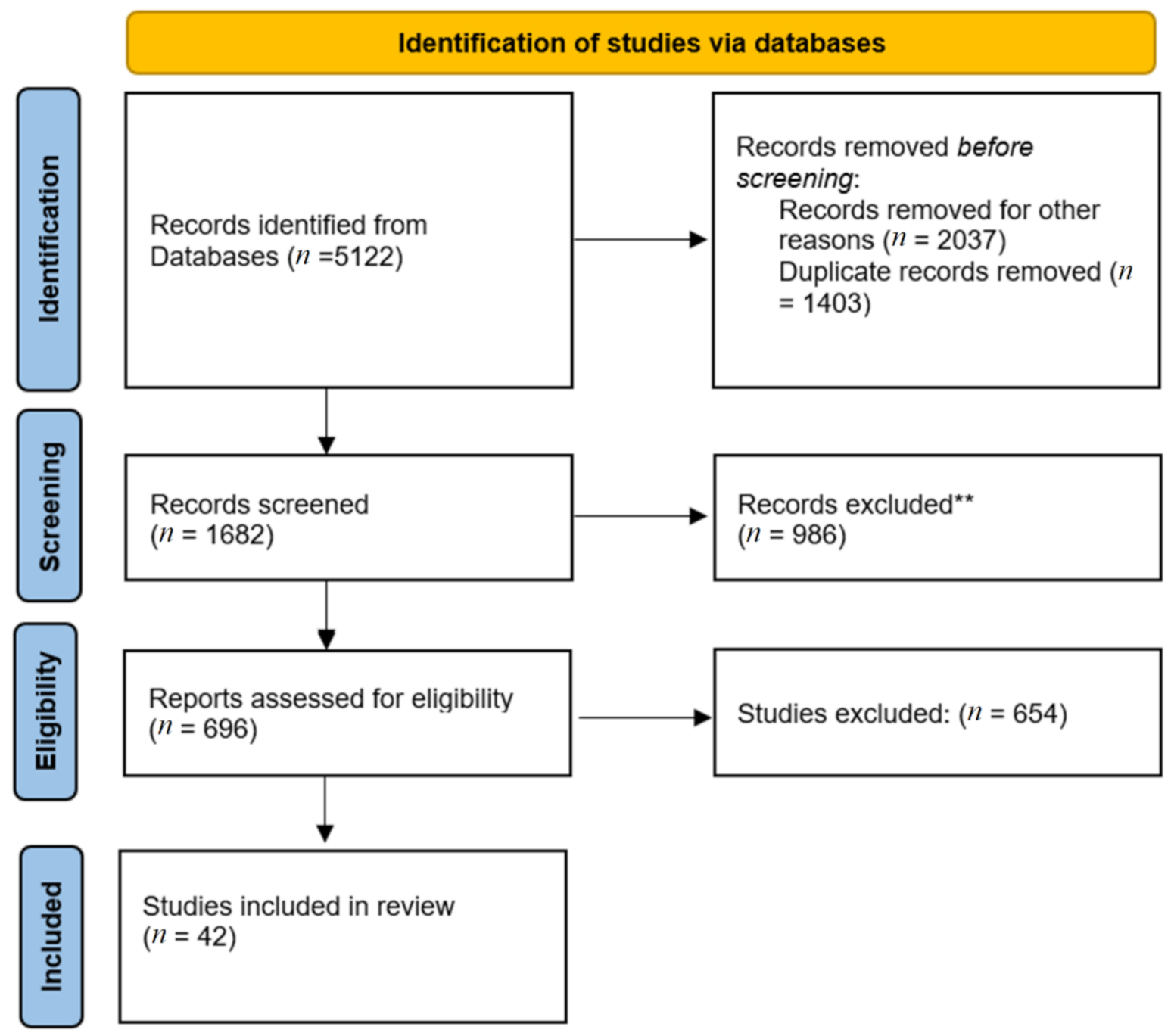
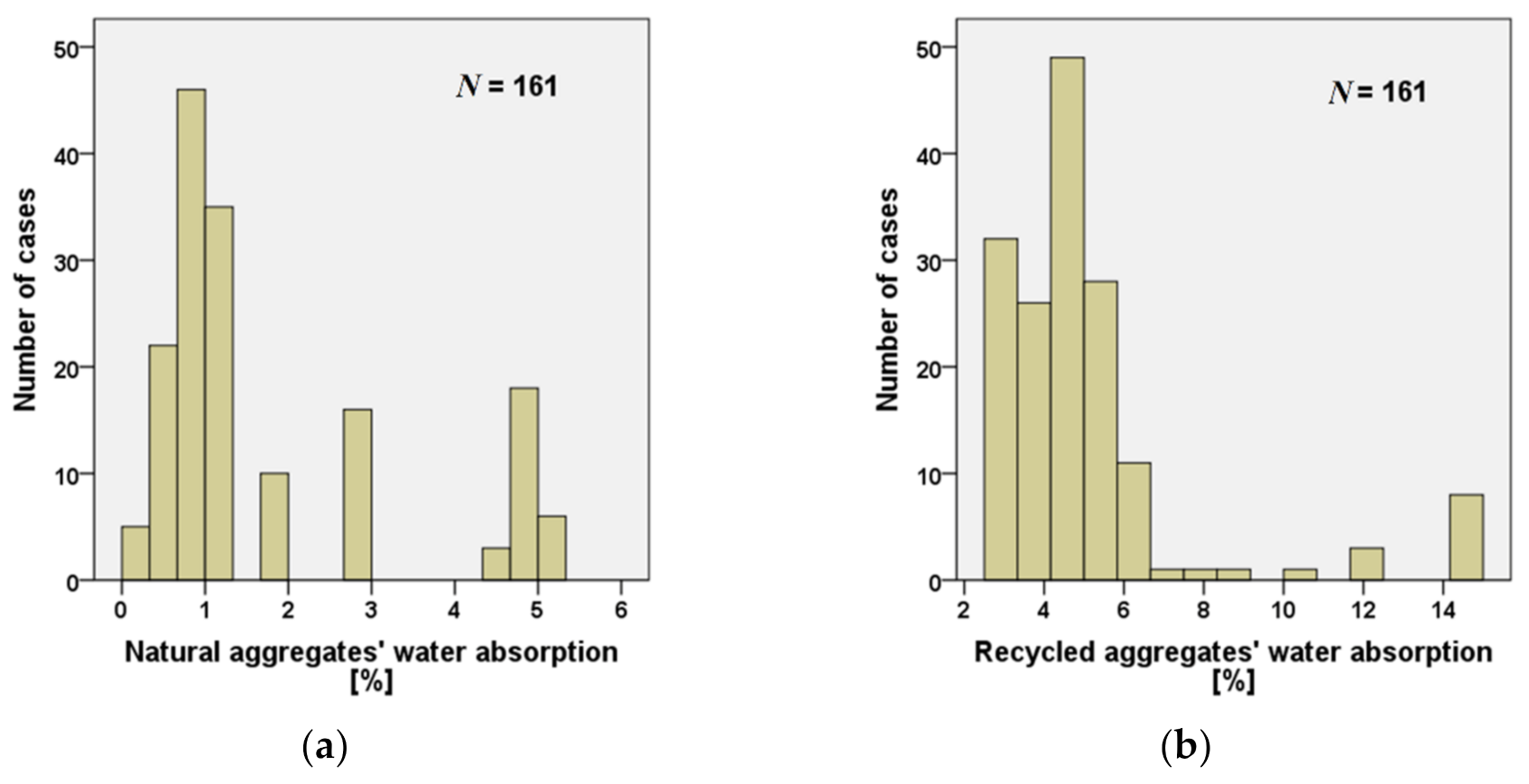
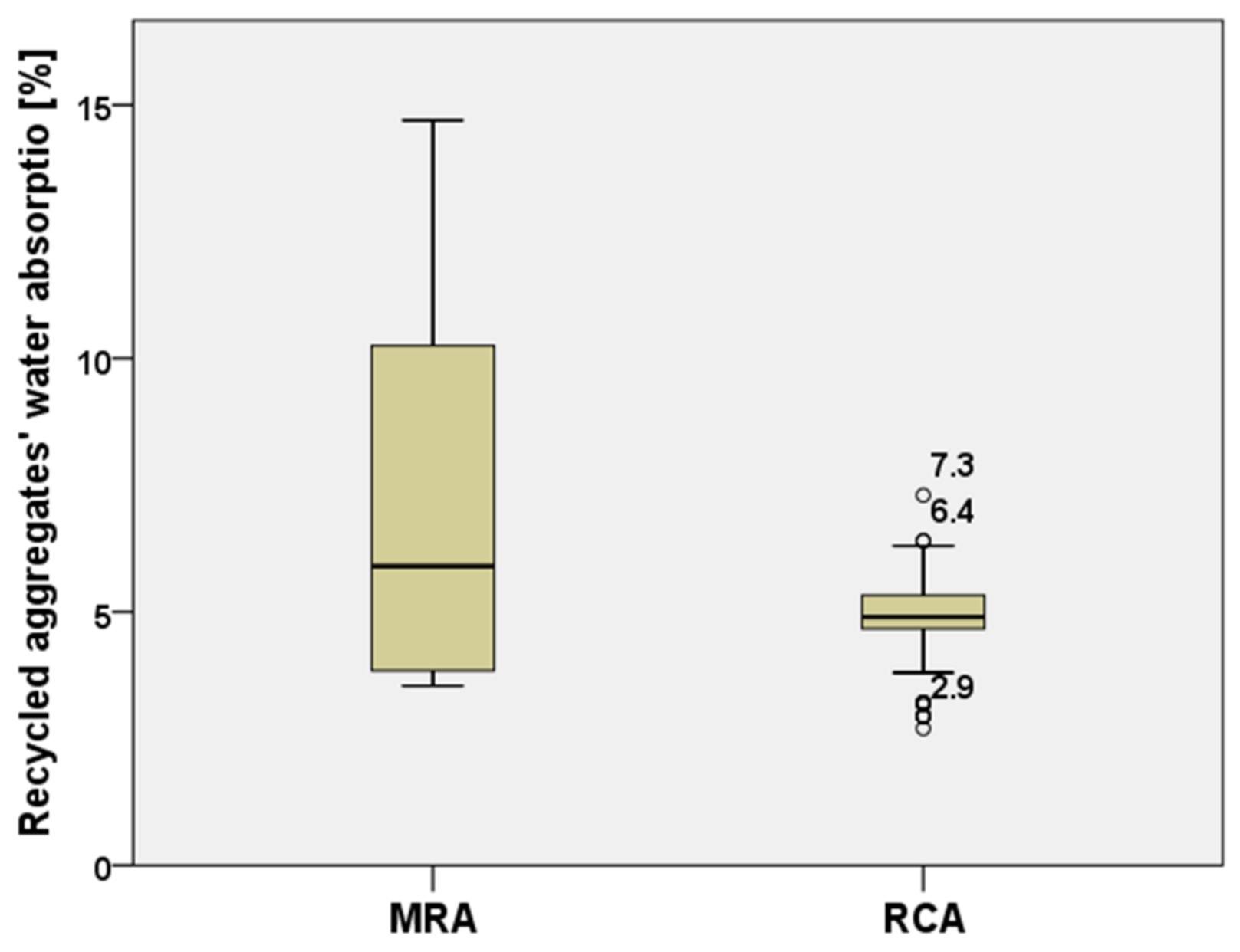



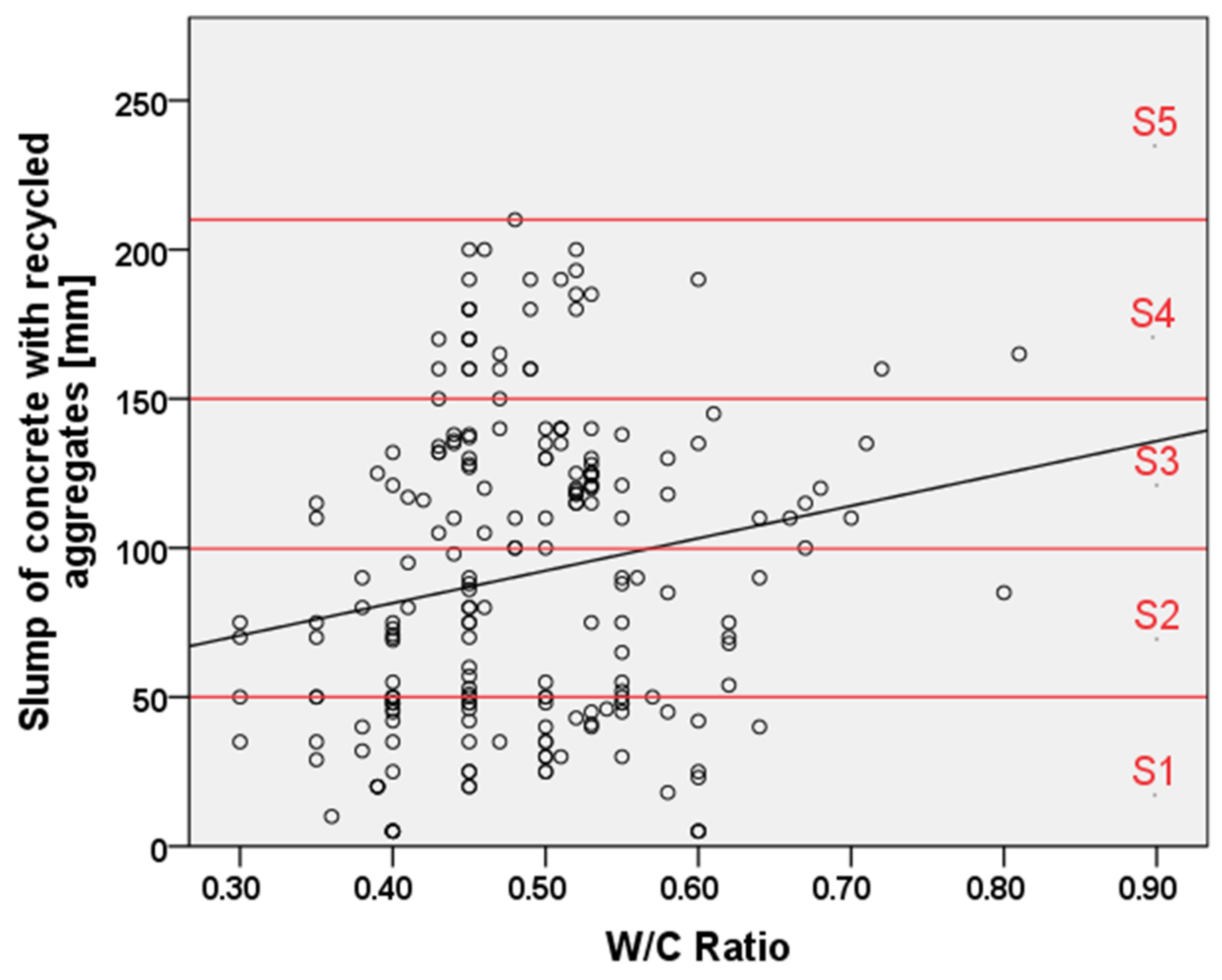
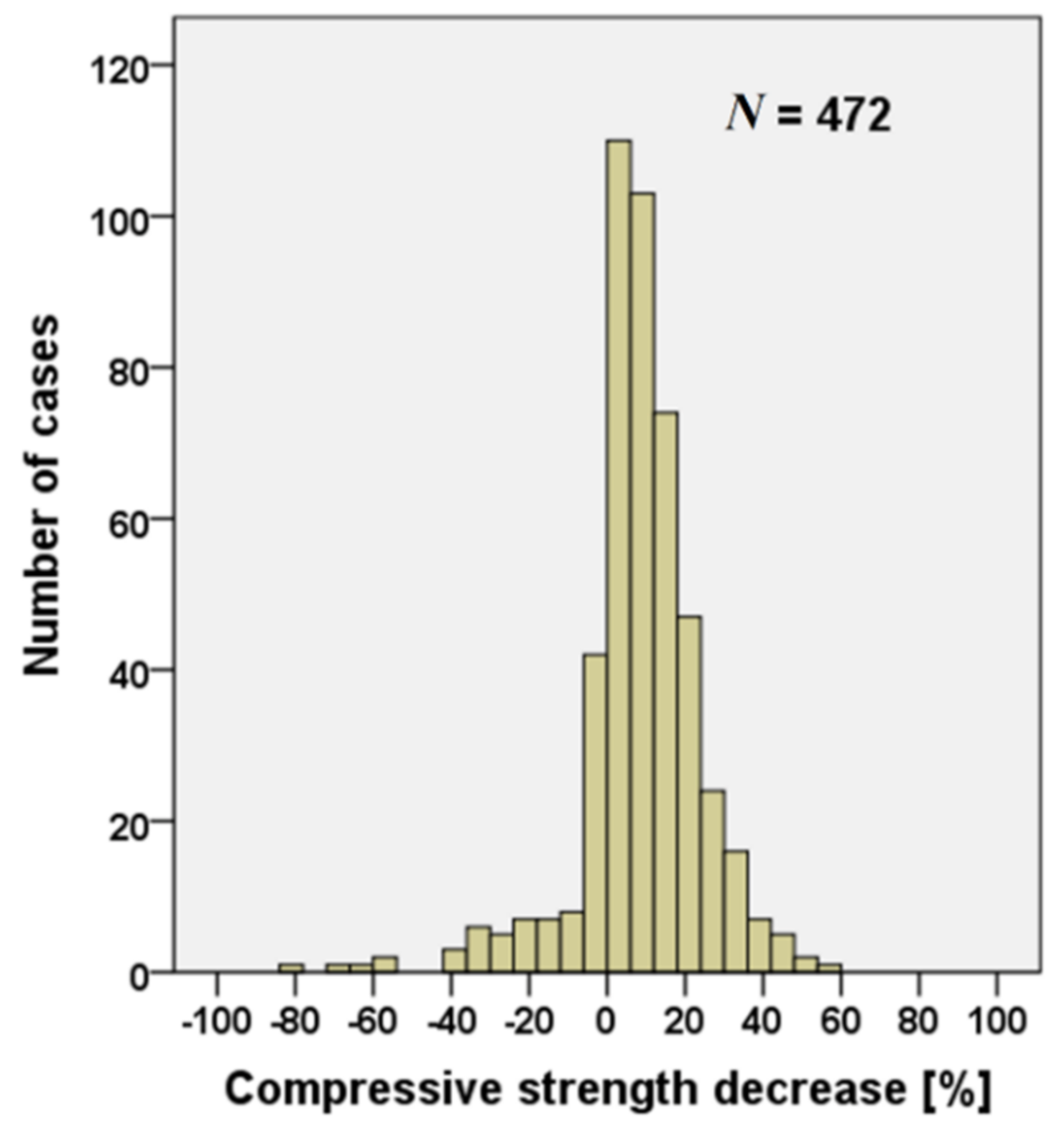

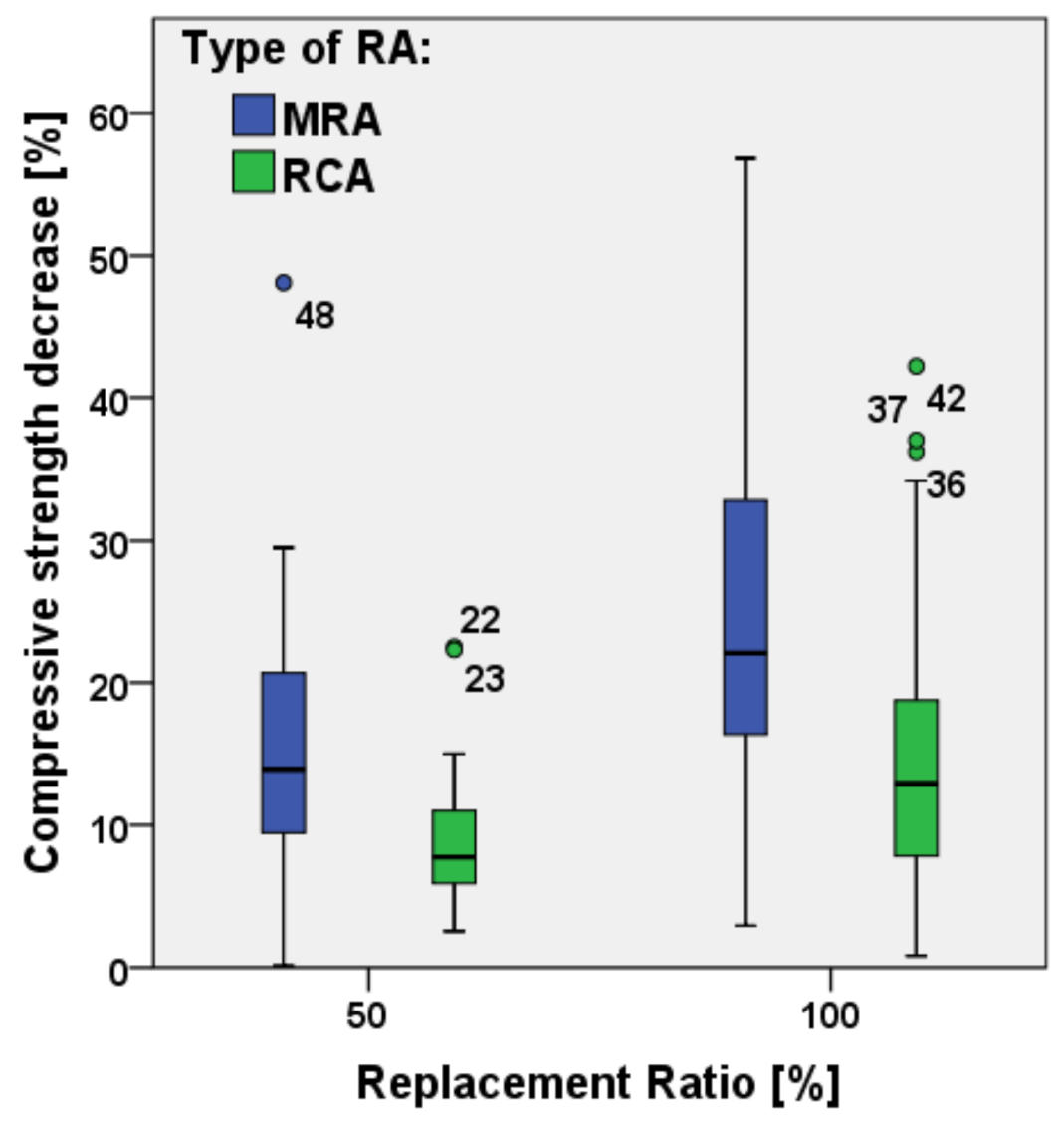
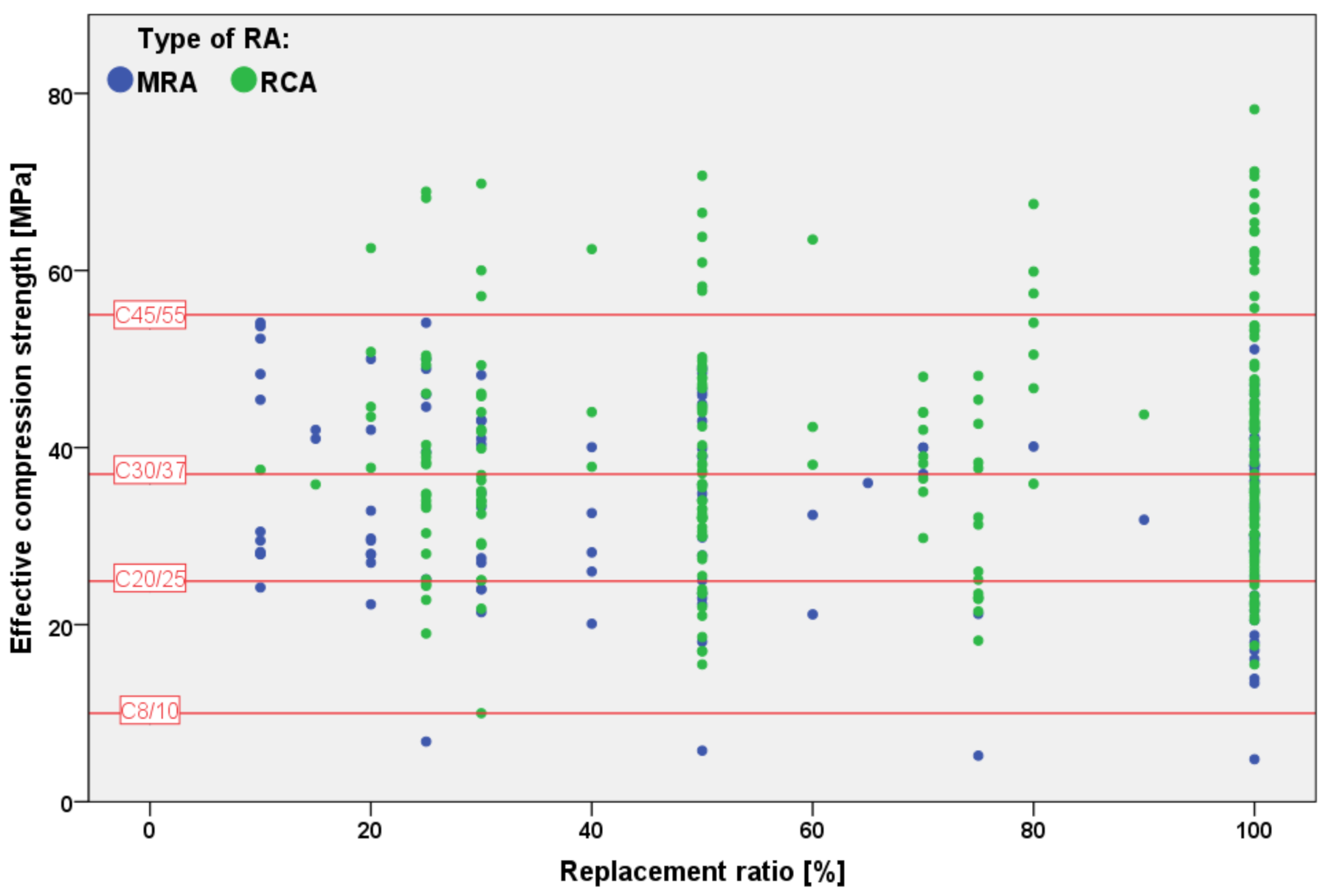
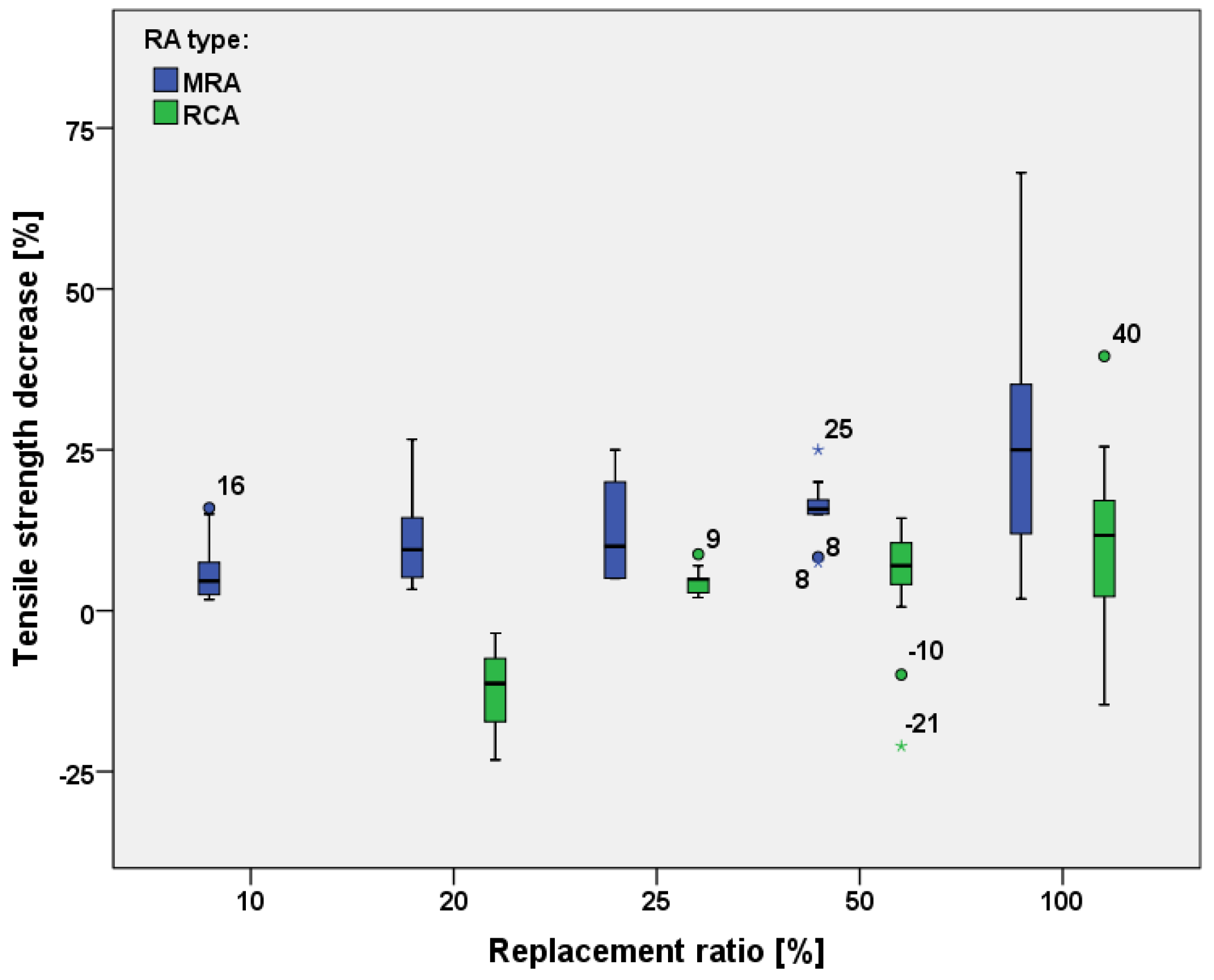
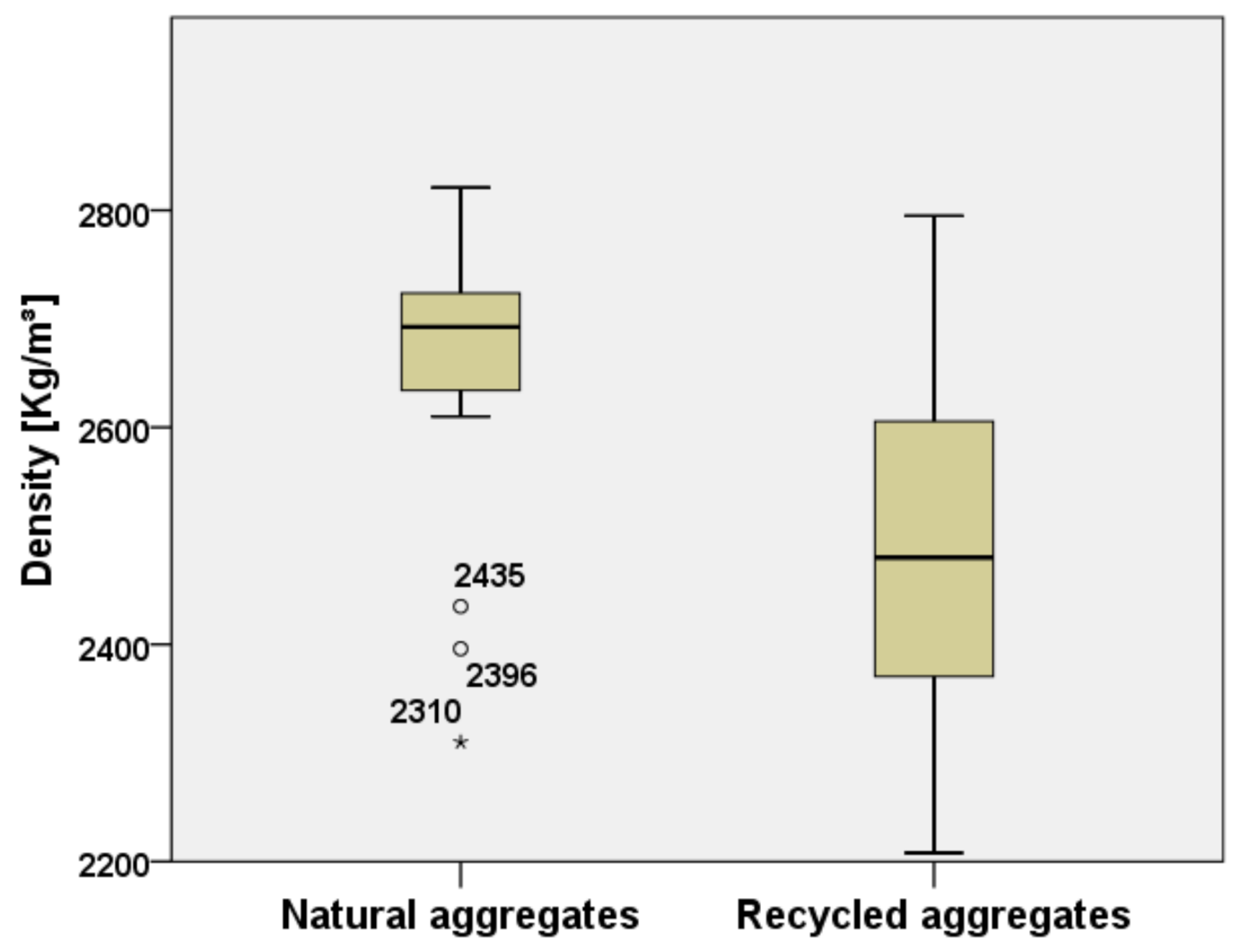
| Main Keyword | Secondary Keyword | Third Keyword |
|---|---|---|
| Concrete | Recycled Aggregates | w/c ratio |
| Workability | ||
| Recycled materials | Origin | |
| Dimension | ||
| Recycled concrete | Compressive Strength | |
| Monolithic or tank test |
| Natural Aggregate WA [%] | Recycled Aggregate WA [%] | |
|---|---|---|
| Average value | 1.71 | 5.13 |
| Minimum | 0.05 | 2.70 |
| Maximum | 5.20 | 14.70 |
| Substitution Percentages and RA Type | Minimum Compressive Strength Decrease [%] | Maximum Compressive Strength Decrease [%] |
|---|---|---|
| 50% MRAs | 0.13 | 48.11 |
| 50% RCAs | 2.54 | 22.50 |
| 100% MRAs | 2.94 | 56.83 |
| 100% RCAs | 0.81 | 42.20 |
Publisher’s Note: MDPI stays neutral with regard to jurisdictional claims in published maps and institutional affiliations. |
© 2022 by the authors. Licensee MDPI, Basel, Switzerland. This article is an open access article distributed under the terms and conditions of the Creative Commons Attribution (CC BY) license (https://creativecommons.org/licenses/by/4.0/).
Share and Cite
Piccinali, A.; Diotti, A.; Plizzari, G.; Sorlini, S. Impact of Recycled Aggregate on the Mechanical and Environmental Properties of Concrete: A Review. Materials 2022, 15, 1818. https://doi.org/10.3390/ma15051818
Piccinali A, Diotti A, Plizzari G, Sorlini S. Impact of Recycled Aggregate on the Mechanical and Environmental Properties of Concrete: A Review. Materials. 2022; 15(5):1818. https://doi.org/10.3390/ma15051818
Chicago/Turabian StylePiccinali, Andrea, Alessandra Diotti, Giovanni Plizzari, and Sabrina Sorlini. 2022. "Impact of Recycled Aggregate on the Mechanical and Environmental Properties of Concrete: A Review" Materials 15, no. 5: 1818. https://doi.org/10.3390/ma15051818






